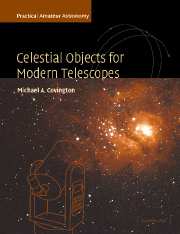Book contents
- Frontmatter
- Contents
- Preface
- Part I Amateur astronomy
- 1 Using this book effectively
- 2 Observing sites and conditions
- 3 The Moon, the Sun, and eclipses
- 4 The planets
- 5 Comets, asteroids (minor planets), and artificial satellites
- 6 Constellations
- 7 Stars – identification, nomenclature, and maps
- 8 Stars – physical properties
- 9 Double and multiple stars
- 10 Variable stars
- 11 Clusters, nebulae, and galaxies
- Part II 200 interesting stars and deep-sky objects
- Appendices
- Index
5 - Comets, asteroids (minor planets), and artificial satellites
Published online by Cambridge University Press: 22 September 2009
- Frontmatter
- Contents
- Preface
- Part I Amateur astronomy
- 1 Using this book effectively
- 2 Observing sites and conditions
- 3 The Moon, the Sun, and eclipses
- 4 The planets
- 5 Comets, asteroids (minor planets), and artificial satellites
- 6 Constellations
- 7 Stars – identification, nomenclature, and maps
- 8 Stars – physical properties
- 9 Double and multiple stars
- 10 Variable stars
- 11 Clusters, nebulae, and galaxies
- Part II 200 interesting stars and deep-sky objects
- Appendices
- Index
Summary
Small objects in the Solar System
A century ago, astronomers' picture of the Solar System was neat and clear. There were eight planets and an asteroid belt, a set of small, rocky bodies between the orbits of Mars and Jupiter, presumably the remains of a planet that had exploded or never formed.
By 1950 the picture was a bit less tidy. One planet, Pluto, was abnormally small and had an odd orbit. A few asteroids had been discovered with orbits outside the asteroid belt.
Today the situation is even less neat, and we are having to rethink old categories. Though the belt between Mars and Jupiter is predominant, there are asteroids all over the Solar System, including a second belt, the Kuiper (KHOY-per) Belt, outside the orbit of Neptune.
There is no longer a clear distinction between asteroids and comets; the asteroid 2060 Chiron has played both roles. It now appears that a comet is merely an icy asteroid from the outer Solar System that has been deflected close enough to the Sun to vaporize the ice.
The distinction between asteroids and planets is also becoming blurred; some scientists want to reclassify Pluto as the largest Kuiper-belt asteroid. Meanwhile, some planetary satellites, such as Mars' potato-shaped companions Phobos and Deimos, are physically indistinguishable from asteroids.
- Type
- Chapter
- Information
- Celestial Objects for Modern TelescopesPractical Amateur Astronomy Volume 2, pp. 62 - 79Publisher: Cambridge University PressPrint publication year: 2002

